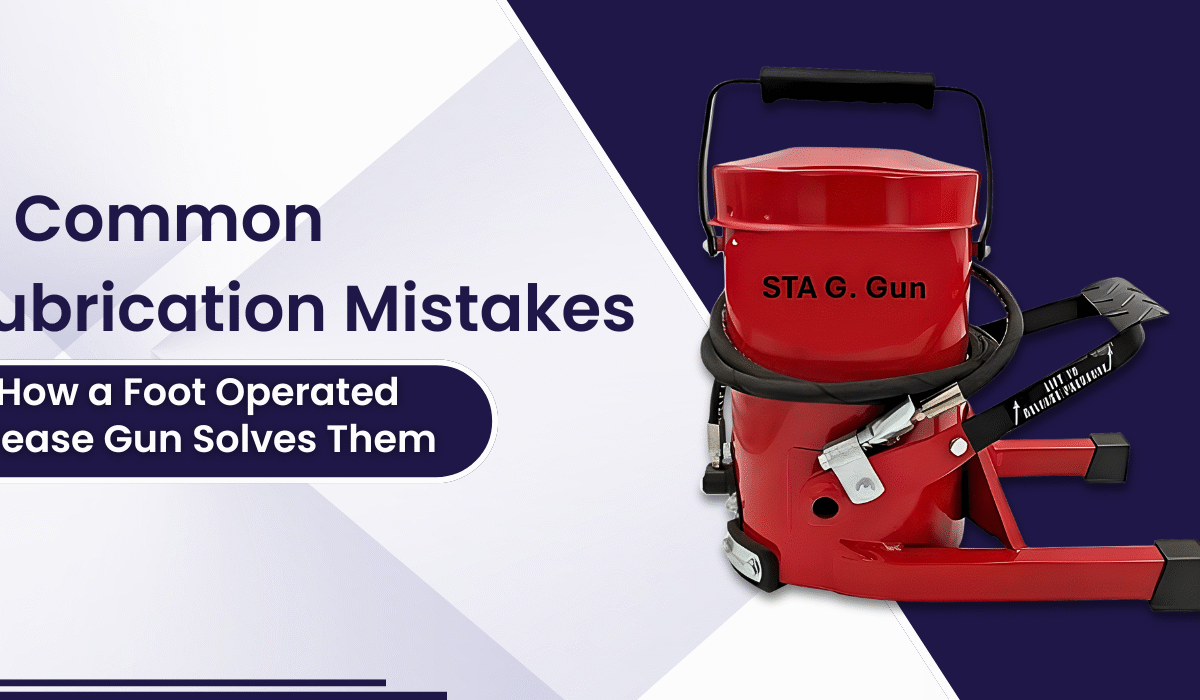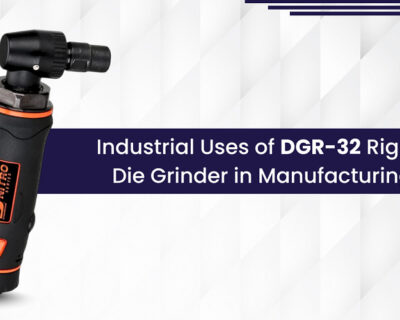Blog

5 Common Lubrication Mistakes and How a Foot Operated Grease Gun Solves Them
Where Downtime Really Begins
Every plant manager has seen it – a critical bearing seizes mid-shift, a conveyor line grinds to a halt, and production losses start clocking in by the minute. What’s often labeled as a “mechanical issue” is, in reality, a lubrication failure.
According to a study by the Machinery Lubrication Institute, nearly 40% of industrial equipment breakdowns can be traced to poor lubrication practices. Whether it’s too much grease, too little, or contamination during handling, lubrication errors quietly undermine operational reliability and eat into maintenance budgets.
For Plant Managers, Industrial Maintenance Engineers, and Reliability Teams, the message is clear: precision lubrication is not optional – it’s foundational to uptime, efficiency, and safety. This article examines the five most common lubrication mistakes observed across manufacturing, heavy equipment, and utility sectors, and shows how the foot operated grease gun has emerged as a simple yet high-impact solution.
1. Over-Greasing Critical Bearings
The Mistake:
Many technicians assume “more is better.” Over-greasing, however, traps heat and pressure inside the bearing housing, leading to seal failure, lubricant oxidation, and accelerated wear. The result? Bearings that should last years fail within months.
The Solution:
A foot operated grease gun provides metered, consistent delivery. Unlike hand pumps that surge or spurt, a foot pedal allows the operator to maintain controlled pressure and monitor flow in real time. Both hands stay free to secure couplers and fittings, enabling precise application.
Industry Data:
SKF Bearing Maintenance Reports indicate that bearings filled beyond 50% capacity experience up to 40% shorter service life. Controlled flow is key – something a foot pump delivers naturally.
2. Inconsistent Lubrication Frequency
The Mistake:
Without standardized intervals, lubrication becomes reactive – done only when noise or vibration appears. Irregular schedules create dry friction zones that accelerate fatigue and increase unplanned downtime.
The Solution:
Foot-operated grease guns encourage routine, repeatable application. Their ease of use and ergonomic design make them ideal for integrating into preventive maintenance cycles. When paired with a lubrication chart or tagging system, technicians can service multiple fittings efficiently and consistently.
Standard Alignment:
Following ISO 17359 for condition-based maintenance, consistent lubrication scheduling reduces bearing temperature fluctuations and extends mean time between failures (MTBF).
Supporting Data:
The Plant Engineering Maintenance Study 2024 found that plants with structured lubrication programs saw 15–20% fewer breakdowns compared to those using ad-hoc methods.
3. Contamination from Dirty Grease Handling
The Mistake:
Open pails, unsealed cartridges, and manual transfer introduce contaminants – dust, moisture, and fibers – that degrade grease integrity. Even a trace of abrasive debris can destroy a bearing surface within weeks.
The Solution:
A sealed, foot-operated grease gun system eliminates exposure. Grease moves directly from a closed container to the lubrication point, reducing airborne or contact-based contamination. The foot pedal ensures hands stay clean, minimizing the chance of foreign particles entering sensitive zones.
Industry Standard:
ISO 4406 cleanliness codes underscore that particles above 14μm can cut bearing life by up to 20%. Using sealed systems drastically improves lubricant cleanliness ratings and overall equipment health.
4. Operator Fatigue and Safety Hazards
The Mistake:
Hand-operated grease guns demand repeated wrist and arm pressure, leading to muscle fatigue, repetitive strain injuries, and inconsistent greasing over long shifts. This not only impacts productivity but also increases error rates.
The Solution:
Foot-operated systems utilize body weight for pressure generation, eliminating wrist strain and allowing continuous, stable flow. The operator remains in a neutral, upright position – reducing fatigue and improving accuracy.
Safety Compliance:
This ergonomic benefit aligns with OSHA ergonomic safety guidelines, which emphasize mechanical assistance for repetitive maintenance tasks. A fatigue-free operator is far less likely to skip fittings or apply grease incorrectly.
Added Advantage:
Because the operator’s hands are free, both precision and safety increase – especially in confined spaces or elevated positions.
5. Inaccurate Pressure Delivery
The Mistake:
Different fittings and machinery components require distinct grease pressures. Applying too much pressure can rupture seals; too little leaves critical zones dry. Hand pumps rarely provide consistent or measurable output.
The Solution:
Foot-operated grease guns deliver smooth, adjustable pressure, typically in the range of 3000–7000 psi. This controlled output ensures compatibility with delicate bearings, high-load joints, and sealed housings alike.
Verification Insight:
Manufacturers such as Lincoln Industrial and Alemite highlight that consistent pressure flow improves lubricant penetration by up to 25%, reducing friction and extending bearing life cycles.
Beyond Efficiency: The ROI of Precision Lubrication
Transitioning to a foot operated grease gun is more than a convenience – it’s a strategic maintenance upgrade. By eliminating overuse, contamination, and operator fatigue, companies can achieve tangible financial gains:
- Up to 30% reduction in grease consumption annually
- Extended equipment lifespan by 25–40%
- Improved safety metrics through ergonomic compliance
These gains compound over time, directly impacting cost per unit, mean time to repair (MTTR), and total maintenance overhead.
Key Takeaway: Precision, Control, and Reliability in Every Pump
Foot-operated grease guns embody the three traits modern maintenance demands: precision, control, and clean performance. They address the five most frequent lubrication errors while supporting ISO-aligned preventive maintenance programs. For high-duty environments – from automotive plants to heavy fabrication units – they deliver measurable improvements in uptime and operator well-being.





